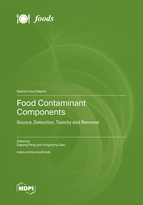Food Contaminant Components: Source, Detection, Toxicity and Removal
A special issue of Foods (ISSN 2304-8158). This special issue belongs to the section "Food Quality and Safety".
Deadline for manuscript submissions: closed (25 April 2023) | Viewed by 45237
Special Issue Editors
Interests: rapid detection technology; veterinary drug residues; animal derived food; food safety
Special Issues, Collections and Topics in MDPI journals
Interests: agricultural standardization; quality and safety risk monitoring and assessment of agricultural products; combined toxicity effect study of mixed pollutants in agricultural products
Special Issue Information
Dear Colleagues,
The contaminants in food (e.g., heavy metals, foodborne pathogenic microorganisms, pesticides, veterinary drugs/antibiotics, toxins, prohibited additives, and allergens) can seriously threaten the ’health of human beings. In recent years, research on the source, detection, toxicity, and removal of food contaminant components has undergone rapid development and achieved tremendous progress through the painstaking efforts of researchers. Therefore, the aim of this Special Issue is to provide a broader perspective of the latest advances in the source, detection, toxicity, and removal of food contaminant components. In this Special Issue, we aim to address: 1) Where do these contaminant components come from? How can we detect these contaminant components? How toxic are these contaminant components? How can we remove these contaminant components? Methodological advances in all areas of food contaminant components, from fundamental research to applied research, can be covered. We welcome both original research and review articles on topics including, but not limited to:
- food contaminants;
- sources;
- metabolism;
- biotransformation;
- toxicity;
- elimination;
- excretion;
- detection;
Prof. Dr. Dapeng Peng
Prof. Dr. Yongzhong Qian
Guest Editors
Manuscript Submission Information
Manuscripts should be submitted online at www.mdpi.com by registering and logging in to this website. Once you are registered, click here to go to the submission form. Manuscripts can be submitted until the deadline. All submissions that pass pre-check are peer-reviewed. Accepted papers will be published continuously in the journal (as soon as accepted) and will be listed together on the special issue website. Research articles, review articles as well as short communications are invited. For planned papers, a title and short abstract (about 100 words) can be sent to the Editorial Office for announcement on this website.
Submitted manuscripts should not have been published previously, nor be under consideration for publication elsewhere (except conference proceedings papers). All manuscripts are thoroughly refereed through a single-blind peer-review process. A guide for authors and other relevant information for submission of manuscripts is available on the Instructions for Authors page. Foods is an international peer-reviewed open access semimonthly journal published by MDPI.
Please visit the Instructions for Authors page before submitting a manuscript. The Article Processing Charge (APC) for publication in this open access journal is 2900 CHF (Swiss Francs). Submitted papers should be well formatted and use good English. Authors may use MDPI's English editing service prior to publication or during author revisions.
Keywords
- source
- detection
- metabolism
- risk assessment
- analysis
- toxicity
- removal
- elimination








